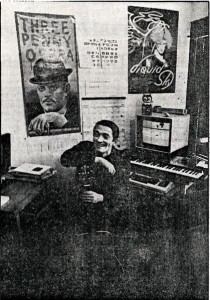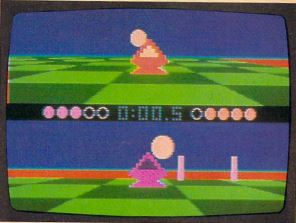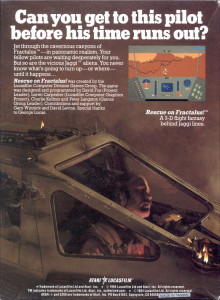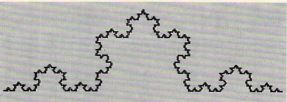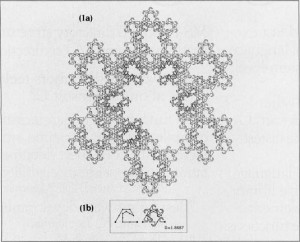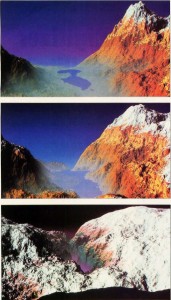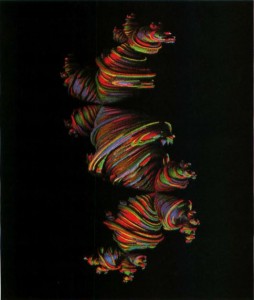There are at least two stories to tell about the way that George Lucas’s Star Wars movies changed the world. One is the tale of the impact the films themselves had on the culture of movie-making and movie-going. For better or for worse, the first Star Wars film ushered out the brief New Hollywood era of auteur-driven American film-making that had followed the collapse of the old studio system in the 1960s, whilst ushering in, with a strong assist from Lucas’s buddy Steven Spielberg’s Jaws, the era of the action-packed, escapist blockbuster that still persists to this day. And of course for the nerdier culture of 1980s gaming Star Wars became nothing less than a third great holy text to join Star Trek and The Lord of the Rings, which does much to explain why it keeps showing up around these parts.
Yet there’s also another Star Wars story that’s less appreciated. During the production of the first film and especially when the millions began to pour in after its release, Lucasfilm, Lucas’s production company, forever changed many of the technologies behind media creation and consumption. To say they did so “quietly” would be overstating the case. Some of the names associated with the technological side of Lucasfilm — Industrial Light and Magic, THX, Pixar, Skywalker Sound — are well known to just about everyone. But the actual nuts and bolts of the new developments, even of those pieces that hide behind one of those big names, can be difficult to appreciate for anyone who isn’t a professional working in one of the industries whose practices they revolutionized. I don’t propose to tell the full story of Lucasfilm the technology incubator here. (That’s actually already been done, and much better than I possibly could at that, in Michael Rubin’s Droidmaker.) I do, however, want to tell you about what it meant to the world of computer games. Like a surprising number of things at Lucasfilm, game development just seemed to happen of its own accord, as something the guy who made Star Wars just really ought to be involved in. It wasn’t initiated by Lucas or any of his cronies, but rather by Atari, who came for a visit in 1982, just as both companies were at the peak of their power, wealth, and influence.
That meeting would mark the beginning of Lucasfilm’s direct association with computer games, but their association with computers in general stretches back considerably farther, to the immediate aftermath of Star Wars‘s release and massive success. Made using traditional mechanical, analog techniques — scale models, stop-motion photography, blue-screening, etc. — Star Wars had been an exhausting film to shoot and edit, so much so that it had sent Lucas to the hospital on one occasion with a stress-induced panic attack. With plans already afoot to make many more films in the series, he was naturally eager to find ways of easing the burden of unglamorous, mind-numbing labor that still was film-making of any stripe — much less a special-effects-driven science-fiction epic — in the 1970s. He started collecting talented computer people to help with that process. This collecting was made much easier by the fact that Lucas, who had evinced a visceral loathing for the Hollywood machine since the days when their trade unions had denied him work as a camera operator whilst he was still a student, had chosen to center his film-making operation in Northern rather than Southern California, much closer to Silicon Valley than to Hollywood. He wasn’t much interested in computer-generated graphics in the beginning. For a guy like Lucas, who had never darkened the door of a computer-science department in his life, the notion barely existed. What he really wanted was a way to do optical printing — the overlaying of separate shots onto one piece of film — more easily and without the degradation that resulted from analog techniques; a replacement for the huge, hot, noisy machines that editors had to use in conjunction with razor blades, glue, and thousand-page notebooks to — literally in those days — cut movies; an easier way to mix sound; even a good accounting system to keep track of all his millions. The people he found to help with all that and much more would set the world on the path to a digital revolution in filmmaking, creating amongst other things the predecessors to modern digital-compositing software and video-editing programs.
More relevantly to our purposes today, however, his dragnet also scooped up some of the best pure computer-graphics minds in the country — people like Ed Catmull and Alvy Ray Smith, the eventual co-founders of Pixar. Soon joining them was one of the pioneers of fractal graphics, Loren Carpenter, whom they lured away from of all places Boeing after he brought down the house at the 1980 SIGGRAPH computer-graphics conference with the short film you see below.
Brilliant as they were, the little Lucasfilm Graphics Group that coalesced around Catmull, Smith, and Carpenter didn’t often have a lot to actually do in those earliest years. The second Star Wars movie, 1980’s The Empire Strikes Back, made no use of computer-generated imagery. Raised on traditional film-making techniques, Lucas could see the value of other new computer-based technologies that made things like editing and compositing easier, but wasn’t quite sure what to make of images that were born inside a computer. And so, like a number of research groups at Lucasfilm, Graphics tinkered away in benign neglect, refining their techniques and waiting for their big break, showing up at the occasional conference with something amazing, which prompted a steady buzz in magazines like Byte about the groundbreaking things that were apparently happening somewhere within the secret bowels of George Lucas’s Star Wars empire.
Their big break ironically came not from Star Wars but from that other big science-fiction franchise Star Trek. Industrial Light and Magic had been hired by the producers of Star Trek II: The Wrath of Khan to do many of the special-effects shots for that movie. This they mostly accomplished using their traditional models, composites, and stop-motion photography. But there was one big effect, an animation illustrating a terraforming “Genesis device” on an in-film computer screen, that stumped them. The script read simply, “And then the planet transforms… EFX sequence here.” It amounted to a creative blank slate for the Graphics Group to show the world what they could do — or perhaps to show just one man. “This is a sixty-second commercial to George Lucas,” Alvy Smith declared, “to show him what he’s got.” They threw it all in: fractals, 3D modeling, texture mapping, fluid animation. Steven Spielberg, who tended to drop by the Graphics Group far more often than Lucas, loved it, saying it was a “great time to be alive” in a world that had such wonders; Star Trek II producer Harve Bennett was elated; Lucas himself called it a “great camera shot,” which by his laconic standards was gushing praise. Released in June of 1982, Star Trek II became in a sense Pixar’s public debut, thirteen years before Toy Story. Lucas was impressed enough to give Graphics some work to do on the third Star Wars film, 1983’s Return of the Jedi, although they weren’t given the opportunity to make any showstoppers like their Genesis sequence. Undaunted, a prescient Catmull insisted, “We’re going to be making entire films this way someday. We’ll create whole worlds. We’ll generate characters, monsters, aliens. Everything but the human actors will come out of computers.”
In the meantime, there were suddenly games. It was when the Graphics Group had just finished the Genesis sequence that Atari came to their nondescript offices in San Rafael, California, for a visit. Flush with even more cash than Lucasfilm at the time, Atari had quite a variety of research projects in progress, even if they would prove remarkably awful at turning them into finished products to supersede the aged Atari VCS games console. Thus it was natural for them to want to visit another company’s cutting-edge graphics research facility and see what they were up to. The two companies were hardly strangers; Atari had just released a licensed VCS game based on Raiders of the Lost Ark, Lucas’s hit cinematic collaboration with Spielberg.
What Atari saw in San Rafael blew them away. The delegation bombarded the bemused Catmull, Smith, and Carpenter with a million questions about how their stuff worked and, most importantly, how it might be adapted to videogames. Only Carpenter showed any real interest at all in such an endeavor. They were used to working on big workstations and minicomputers, not primitive micros, which they viewed with a certain contempt, dubbing their programmers mere “bit twiddlers.” They had high standards for their visuals: their graphics had to be good enough not to look out of place projected on a huge movie screen surrounded by other imagery shot on pristine 35-millimeter film. Their greatest enemies were what they called the “jaggies,” visibly blocky, pixelated areas that tended to lurk at the margins of what should be smooth, flowing curves. While the jaggies could be held at bay using the state-of-the-art, processing-intensive anti-aliasing techniques that the Graphics folks had spent years developing at Lucasfilm and elsewhere, those techniques weren’t much applicable to an 8-bit games console. Catmull and Smith at least wanted no part of that action; Carpenter was intrigued but also ambivalent, certainly not willing to entirely give up his film work for a game project.
Yet Atari persisted. Even Manny Gerard, the Warner Brothers executive who had orchestrated that company’s purchase of Atari, got involved, saying that “we ought to be in business” with Lucasfilm’s Graphics Group. Finally Atari offered to flat-out give Lucasfilm $1 million to set up a Games Group, for the products of which Atari would receive “right of first refusal” as publisher. An offer like that was hard to refuse. The deal was announced at the Summer Consumer Electronics Show in June of 1982. “We’ll be developing new forms of electronic entertainment,” said an excited Atari, “and the term ‘electronic entertainment’ is carefully chosen.” Don’t, in other words, just call them yet more videogames. Lucasfilm and Atari would continue to work hard to cultivate this rarefied image of Lucasfilm Games as artists of interactivity rather than mere game programmers over the months and years to come.
Had Atari not so aggressively forced their hand, one might be tempted to characterize the whole undertaking as something of a bait and switch on the part of Lucasfilm; no one currently in that Graphics Group whose work had so impressed Atari was earmarked to start working full-time on games. Still, the initial organization of an entirely new Games Group was tossed into the lap of the Graphics Group’s Ed Catmull, who found a fellow named Peter Langston at a Wall Street law firm to head it. Langston was a Unix hacker from way, way back who in 1971 had written Empire, an elaborate multiplayer strategy game played on a global scale, a forerunner to Civilization and other games of its ilk. (A later offshoot of the original game was even named Civilization.) An accomplished musician, he was very interested in the application of music theory to computers and vice versa and was, in the judgment of Catmull, just a visionary “star” in general, the perfect guy to take Games off his hands. When Langston, who was quite happy in New York, proved reluctant, Catmull continued to sweeten the deal, going so far as to offer to fly him back to New York for a couple of weeks out of every month if he liked. It was, once again, an offer that was hard to refuse. Catmull got his guy, and with a sigh of relief turned his attention back to film graphics.
Langston was an unusual choice for leader and administrator, a conceptual rather than an altogether practical thinker with a somewhat dreamy disposition. Working at the unhurried pace that would be typical of the young Games Group, he put a little team together to join him. He held the zap-em blast-em world of typical videogames in little more regard than did his colleagues in Graphics, and thus purposely avoided programmers with a lot of experience in the industry; he was after people like him, people who were “a little bit visionary.” He hired one David Fox because he admired Computer Animation Primer, a book Fox had recently written for which he had actually met and interviewed many members of the Graphics Group. It took him weeks more to settle on a very eager David Levine as a third team member. His biggest claim to fame was having designed the first add-on graphics board for the original Altair kit computer, which Langston thought was great. However, he’d also already done quite a lot of videogame programming, which maybe wasn’t so great. In the end Langston decided to give him a shot in spite of his surfeit of experience. A fourth employee, Charlie Kellner, late of the Apple Macintosh development team (another musician, he had programmed the pleasant little beep the Mac made at startup), would arrive still later. Like Graphics and many other teams benefiting from the Star Wars millions inside Lucasfilm at the time, Games walked a shadowy, largely unsupervised line somewhere on the intersection of a pure research group and a commercial proposition expected to deliver actual, tangible products. Certainly Games was nothing like the quickie projects being started by many other big companies to cash in on the videogame fad. Nor would they try to trade on the Star Wars name. In fact, they wouldn’t even be allowed to make Star Wars games.
Whilst negotiating with 20th Century Fox the deal that would lead to Star Wars, George Lucas had agreed to license the right to make Star Wars “toys and games” to Kenner Products. At a time when videogames still largely meant Pong, everyone interpreted “games” in this context to mean board games, which would be issued by Kenner’s subsidiary Parker Brothers, whose stable already included family perennials like Monopoly, Risk, and Clue. When videogames exploded a year or two later in the wake of Space Invaders (whose popularity was itself fed by Star Wars and the craze for all things science fiction that it engendered), Parker Brothers found themselves gifted with a golden goose for the ages, as was amply proved when they released an Atari VCS cartridge based on The Empire Strikes Back that spent many months in the top ten. The Star Wars videogame-licensing rights would be tied up in knots for years to come, the interested parties including not only Lucasfilm and Parker Brothers but also Atari, whom the latter agreed to allow to make standup arcade games and eventually console and computer games of their own under the name. (One way or another, everything involving videogames in the early 1980s always seemed to come back to Atari.) The end result was a circular tangle the likes of which only corporate America could create. Lucasfilm, the owner of Star Wars, had a games division that wasn’t allowed to make Star Wars games, while Atari had such a license thanks to kicking some money back to board-game manufacturer Parker Brothers, but chose to create those games in-house, even though they’d just paid Lucasfilm $1 million to set up the aforementioned games division for the purpose of making games for them. The upshot, however, was simple: no Star Wars for Langston, Fox, and Levine, nor for that matter for any of the others that would join them over the course of the rest of the decade. Many who were at Lucasfilm Games during this period have since remarked on what a blessing in disguise this really was, forcing the developers as it did to come up with original game concepts, original game fictions.
Even if they were barred from working directly with the Star Wars intellectual property, it was a damn good gig just to work for Lucasfilm, flush with cash, with all of the best equipment, with few or no hard deadlines, and right there on the close periphery of where the movie magic happened. If George Lucas himself seldom poked his head in the door, there was every day the possibility that he would. And there were other famous faces who were a more common sight, like Steven Spielberg, who spent quite some hours in between Industrial Light and Magic effects shots for Indiana Jones and the Temple of Doom camped out in the Games Group’s offices playing the Star Wars standup arcade machine Atari had been kind enough to send them. One day Spielberg recruited the team to become the screams of dying bad guys in Temple of Doom. Whatever else competing games studios might offer, they couldn’t offer experiences like these.
Of course, being constantly in the shadow of Star Wars and Indiana Jones could also be exhausting in its own way. David Fox tells the story of attending an early trade convention where a showgoer, excited by the games on offer, for once failed to make the connection, asking what else Lucasfilm had made: “I said, ‘We made the Star Wars films.’ Watching the look on his face was hilarious as he made the connection. And it was nice for once to not be in the shadow of the films!”
As for what they were actually working on in those early days… well, that wasn’t always entirely clear, at least for those looking in from the outside. They had unilaterally decided quite quickly not to develop their first games for the technologically antiquated Atari VCS games console, as Atari had anticipated, but rather to target the Atari 8-bit line of home computers and the new, more advanced Atari 5200 console that had largely the same internals as those computers — this even though neither platform was selling in anything like the quantities of the old VCS. Langston pronounced himself “amazed” when his research into the ways that games were typically made for home computers revealed most developers to be working “in a basement on a system with too little memory, too few floppy disks, no reasonable way to make a backup, and few if any debugging tools.” Determined to change all that, the trio spent months on an elaborate development system which ran on their big DEC VAX minicomputer. Conceptualized largely by Langston himself, it allowed them to write code in a LISP-like script, compile it, download it to an Atari 8-bit machine, and debug it as it ran there from their terminals. Similar systems, eventually capable of compiling down to a whole range of other microcomputers, would remain the core of the Games Group’s development methodology for years to come.
Their efforts to create actual games slowly coalesced around two projects, both of which had started as “throwaways,” learning exercises to work the kinks out of their development system and help the team gel. (That very description says much about Peter Langston’s academic style of management, and why Lucasfilm’s own management would in time start to find it kind of infuriating.) David Levine’s baby Ballblazer was the more artsy of the pair, a surreal 3D soccer game played between opposing spacecraft, with realistic if otherworldly physics and, most impressively, jazzy generative music provided by Langston that’s sometimes been compared to that of John Coltrane. The music was created using fractal algorithms pioneered by the Graphics Group that just seemed to be in the air in those San Rafael offices. Speaking of which: David Fox’s Rebel Rescue got a huge assist from Loren Carpenter, the only real games fan in the Graphics Group, who helped him to implement an admittedly jaggies-replete fractal landscape for his more grounded game that cast the player as a futuristic search-and-rescue pilot, trying to rescue downed pilots from a planet’s surface and bring them back to the mothership whilst fighting off hordes of invading aliens that are still swarming the atmosphere. Deciding they might as well have a sense of humor about the thing, they decided to call these aliens the Jaggies. Rebel Rescue would actually have made a darn good Star Wars game; its inspirations, including not only the name itself but also the X-Wing-like spacecraft you fly and the pilots you rescue in their distinctive orange flightsuits, are pretty hard to deny.
George Lucas, for whom games held little personal appeal, sat down with his Games Group exactly once during their first couple of years of existence. And yet his single visit had a huge impact on Rebel Rescue. The little team, idealistic as they were, took pride in the fact that both of their games were basically nonviolent. In Rebel Rescue you could avoid the enemy aliens or, if you were skilled, trick them into flying into mountains, but you couldn’t shoot at them. “Where’s the fire button?” Lucas asked. Fox explained. “Is there no shooting because of gameplay reasons or philosophical reasons?” Philosophical. “Great. Put in a fire button. I want to shoot at things.” It was also Lucas who suggested what would prove to be Rebel Rescue‘s second most memorable feature after the fractal terrain itself: some of the downed pilots are aliens in disguise, whom you have a split-second to zap before they kill you. This was deliberately left out of the game’s manual, thus nearly giving many players a heart attack when it first happened a few levels in.
Even as the team tinkered away with Ballblazer and Rebel Rescue, the Great Videogame Crash of 1983 was happening outside their ivory tower. Nevertheless, at year’s end the Games Group at last delivered working prototypes of both games to an Atari who had declared themselves bloodied but determined to fight on, who were “going to reignite the consumer’s love of videogames.” Just weeks later the Games Group was horrified to see their babies spreading like wildfire across the worldwide network of pirate BBS systems. It seemed that someone at Atari hadn’t been able to resist sharing these cool new games with a friend or two, and the thing had just exploded from there. Soon copies of the games started to show up for sale in flea markets and the less scrupulous software shops, decked out in homemade packaging invented by enterprising quick-buck artists. A still buggy Rebel Rescue in particular seemed to be in the collection of every Atari 8-bit owner on the planet, one of the most popular games on the system. Lucasfilm and Atari had a hit on their hands, but it was a hit they weren’t getting paid for. It was questionable whether Langston and his idealistic cohorts were more upset about the potential purchasers it was costing them or the fact that the games everyone was playing weren’t finished yet.
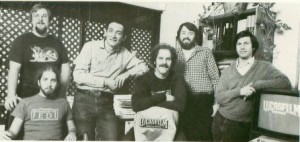
Most of the Lucasfilm Games Group, mid-1984: Charlie Kellner, David Levine (seated), Peter Langston, David Fox, Loren Carpenter (visiting from Graphics), Gary Winnick
Lucasfilm was understandably less than thrilled at Atari’s failure to protect their games. Atari, however, was also less than thrilled with Lucasfilm. It had now been eighteen months since their $1 million investment and, especially in light of their straitening financial circumstances, they wanted to see some finished, polished games in return. They were particularly unhappy that the Games Group had failed to deliver on a promise to give them something ready to show at the 1984 Winter CES. By now Lucasfilm management as well had decided that something had to give. In January of 1984, they hired one Steve Arnold to join Peter Langston as an awkward sort of co-manager. Arnold came from Atari, where he had been responsible for the Atarisoft line of ports of standup-arcade games to home computers, one of the few financial bright spots at the company during 1983. He’d rolled out an astonishing 49 separate conversions in five months as head of Atarisoft, so he certainly knew how to ship product. But a few Lucasfilm higher-ups wryly noted that his best qualification could be his PhD in psychology, or perhaps the time he’d spent years before as program director at a boy’s camp. Hopefully he could find a way to make the unruly Games Group toe the line without spoiling what made them unique in the first place. Also coming aboard around this time were two more team members. One was Noah Falstein, an established videogame designer and programmer late of Williams Electronics, where he’d worked on standup arcade games like Sinistar. The other was the Games Group’s first full-time visual artist, a veteran commercial artist named Gary Winnick.
With these new, somewhat more practical-minded additions, the Games Group did indeed start making progress more quickly; the new can’t-miss-it deadline promised to a still skeptical Atari was now Summer CES in June. Rebel Rescue was renamed Rescue on Fractalus! largely for legal reasons, to make it clear that it was not (officially) a Star Wars game despite the Lucasfilm logo on its box. The folks at Industrial Light and Magic built and photographed model spacecraft for the boxes, designed and built a cockpit model for the “Valkyrie” fighter the player flew in Rescue on Fractalus!, and even made flightsuits for the entire development team to wear in a grand photo spread. David Fox got to play the starring role, as a weary pilot trying to straggle home in his battered Valkyrie on the back of the Rescue on Fractalus! box. The whole effort cost at least $30,000. Yes, working for the company that made Star Wars did have its perks.
Final versions of both games, complete with packaging, were delivered to Atari well before the latest deadline. Lucasfilm held a lavish press conference to unveil them in May, presenting the games via slick videos created with the aid of professional voice actors and Lucasfilm’s general movie-making know-how.
A beleaguered Atari determined to press on (or still in denial) came to Summer CES with a new slogan: “The Day the Future Began.” The “Atari-Lucasfilm” games got a very positive response from press and public alike, and the partners put on the final touches for a July release. Yet practical questions still surrounded them. The Atari 5200 console had proved to be a flop, had already been discontinued, while Atari’s line of 8-bit home computers was still on the market but overshadowed by the cheaper Commodore 64. Meanwhile Atari themselves were still in financial free fall. And then, overnight, everything changed once again.
On July 3, 1984, Warner Communications announced that Jack Tramiel, late of Commodore, was buying Atari’s home-videogame-console and home-computer operations, surprising no one more than the people inside Atari who suddenly had their company sold out from under them. Looking on from the outside as Tramiel axed employees by the thousands in the weeks that followed, the Games Group wondered if July 3 should be called “The Day the Future Ended.” No one seemed to quite know in the midst of all the chaos where it left the Lucasfilm/Atari partnership. Tramiel himself didn’t seem to know much about their companies’ agreement and didn’t much seem to care. And so Steve Arnold set off to try to free the games from Atari’s exclusive clutches. He returned from his one and only meeting with Tramiel with a less than positive personal impression, saying that the latter reminded him of no one so much as Jabba the Hutt of Return of the Jedi fame. Sure enough, pictures of the two were soon hanging up around the offices of a very frustrated Games Group: “The Hutt Brothers: Jabba, Jack.” (Poor Jack just couldn’t win; the common comparison inside Atari itself was to Darth Vader.) But in this one case at least Tramiel’s bark was worse than his bite. Busy with other legal battles and the travails of rebooting Atari, he let Lucasfilm move on.
Arnold settled on Epyx as publisher out of a crowded field of suitors, signing a four-game deal that was announced with considerable fanfare at Winter CES in January of 1985. Ballblazer and Rescue on Fractalus! became widely available for purchase at last shortly thereafter. These, the Games Group’s first actual products, had taken two-and-a-half years to come to fruition, an eternity in an era when most videogames were still churned out in a matter of a few months.
Thankfully for the Lucasfilm brass, it looked likely that the next games wouldn’t be so long in coming. Peter Langston had bowed out at last in the fall of 1984, taking with him his rather abstract approach to game development and freeing Arnold to continue to refine the Games Group’s operations along more practical lines. And there was suddenly plenty of practical work to do. No longer beholden to Atari, they were now free to port Ballblazer and Rescue on Fractalus! from the fading Atari 8-bit line, every owner of which seemed to already have them anyway thanks to the leaked demo versions, to stronger platforms like the Commodore 64, where they ended up selling far more copies. Rescue on Fractalus! in particular became a hit, not a blockbuster and certainly not enough to justify the time and money poured into it absent Atari’s initial $1 million beneficence, but a solid piece of groundwork that established Lucasfilm Games as a maker of classy but accessible action fare. If it seemed just slightly underwhelming in light of the years it had been in production and all of the flashy promotion that surrounded it — seemingly every magazine in the industry published a big Lucasfilm Games feature article around this time; such was the cachet of the house that Star Wars had built — well, just about any game realizable on an 8-bit computer would have. It didn’t help that the year that had passed between the leak of those demo versions and the arrival of the finished games on store shelves had allowed lots of other programmers to start experimenting with fractal graphics, making Rescue on Fractalus! look far less revolutionary than it otherwise would have.
The next two games were very much designed to build on the technical as well as the commercial groundwork laid by the first two; both started with the graphics engine from Rescue on Fractalus!. Designed by Charlie Kellner, a newcomer who had been hired just before Langston left, The Eidolon had the player piloting a machine through networks of underground tunnels inside the protagonist’s own mind — fractally generated, naturally — full of dangerous “guardians of the id.” Koronis Rift hewed still closer to Rescue on Fractalus!: this time you were flying above an alien-infested, fractally-generated planet trying to collect technological relics rather than downed pilots. Both were once again well-reviewed when released in late 1985 after comparatively reasonable one-year development cycles, going on to sell modestly well, if not to match the sales of Rescue on Fractalus!. In the span of 1985 the Games Group had increased their catalog from zero to four solid action games, one of them a genuine hit, and were now largely self-sustaining.
At the same time, though, a slight sense of underachievement clung to the Games Group, who had failed to completely deliver either the revolutionary gameplay experiences for which Peter Langston had been hired or the blockbuster sales figures one might expect from the company of Star Wars. They were still something of an odd duck in the industry, their huge cachet still largely based on that name on their boxes rather than the actual contents of the disks therein. Yet, even after Peter Langston’s departure, the sense of artistic idealism he’d worked so hard to engender remained alongside Steve Arnold’s determination to actually ship games on a semi-regular basis. “I think in general we’ll be moving away from the concept of games,” said Kellner shortly after the release of The Eidolon and Koronis Rift, echoing some of the verbiage Atari and Lucasfilm had used when first announcing the new venture three-and-a-half years before. “We’re trying to produce an experience that’s like being part of a film, rather than just being part of a game.” The fact that they were still having to promise to move beyond mere “game” in the future could be read as an admission that visionary software had proved to be a bit more difficult to develop than expected. On the bright side, their next project would be by far their most audacious and, yes, visionary yet.
(Sources: the book Droidmaker by Michael Rubin; Byte of March 1984; A.N.A.L.O.G. of August 1984, April 1985, August 1985, March 1986; Antic of August 1984, December 1985; Commodore Power Play of August/September 1986, October/November 1986; Compute!’s Gazette of August 1985; Compute! of August 1982, November 1982; Creative Computing of March 1982; Enter of September 1984; Family Computing of August 1986; Game Developer of December 1994; K-Power of September/October 1984; Zzap! of February 1986, March 1986; Retro Gamer 27, 44, 116; the website LucasFans, now available only via the Wayback Machine; Peter Langston’s paper on the early Games Group’s development system, available from his website.)

